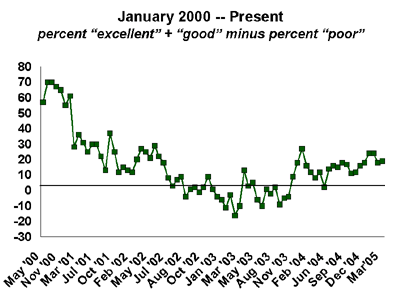GALLUP NEWS SERVICE
PRINCETON, NJ -- Wall Street seems pretty happy with the U.S. economy right now. With oil prices exceeding $50 a barrel, the economy continues to grow and consumers continue to spend. Even the most recent jobs report was better than expected. Add to that the recent Fed report showing U.S. household wealth hit a record $48.5 trillion in the fourth quarter and the strength of today's equity markets makes a lot of sense.
New Gallup Poll economic data (March 7-10), however, show consumers on Main Street to be a lot less happy than the traders on Wall Street. Currently, half the public tells Gallup that economic conditions are getting worse, not better. So why is the average American so much less optimistic about the future of the U.S. economy than many of the economists and investors on Wall Street?
More Americans Say the Economy Is Getting Worse
Only 41% of American consumers say economic conditions in the country as a whole are "getting better" right now compared to 50% who say they are "getting worse." This negative difference of 9 percentage points is the largest since last October, when there was a negative difference of 11 percentage points, with 39% saying things were getting better and 50% saying they were getting worse. It is also three times as large as the negative difference of 3 percentage points recorded a year ago (March 8-11, 2004).

Fewer Americans Say Economic Conditions Are Good/Excellent
In March, 35% of consumers indicated that current economic conditions are "good" or "excellent" while 16% said they are "poor." This positive difference of 19 percentage points is about the same as in late February but less than the positive difference of 24 percentage points in both January and early February of this year.

Why Are So Many Average Americans Pessimistic?
Average American consumers have several good reasons to be less optimistic than they were at the beginning of the year:
- Oil prices are averaging well over $50 per barrel -- up about 50% from a year ago.
- Gas prices at the pump are escalating quickly -- up about 33 cents from a year ago.
- The U.S. trade deficit continues to expand, as does the federal budget deficit.
- Nearly three in four consumers (72%) expect inflation to increase over the next six months, while only 7% expect it to decline.
- Three in four consumers (76%) also expect higher interest rates over the next six months, compared to only 6% who expect lower rates.
How Long Can Wall Street and Main Street Diverge?
As the good news on household wealth reflects, many Americans have benefited as real estate values and the stock market surged. Even now as energy prices escalate, the value of energy related stocks has increased. As a result, it is not surprising that upper-income families are spending more not only on higher-priced necessities but also on other goods and services as well.
On the other hand, lower- and middle-income households have experienced little wage growth. They are being squeezed by higher gas/energy prices. And, they are increasing their debt -- consumer debt increased 11% in 2004. As a result, they are also feeling the impact of higher interest rates even at today's lower levels. According to a March Experian/Gallup Personal Credit Index poll, one in four Americans currently have some form of variable rate credit and one in five Americans say that they are already feeling the pinch of higher interest rates.
In the short term, it is possible for the economic outlook on Wall Street to diverge from that on Main Street. This remains a much better economy for higher-income investors than for average Americans. But, this divergence can't continue for too long. At some point, the squeeze on middle- and lower-income Americans will slow the economy to such an extent that even Wall Street will feel the impact.
Survey Methods
Results in the current survey are based on telephone interviews with 1,004 national adults, aged 18 and older, conducted March 7-10, 2005. For results based on the total sample of national adults, one can say with 95% confidence that the maximum margin of sampling error is ±3 percentage points.
In addition to sampling error, question wording and practical difficulties in conducting surveys can introduce error or bias into the findings of public opinion polls.
